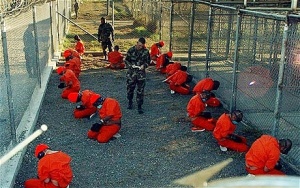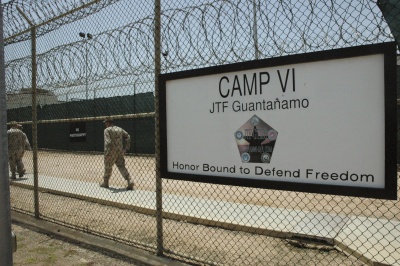Guantanamo Bay detention camp
(Military base, Black site) | |
|---|---|
 | |
| Subpage(s) | •Guantanamo Bay detention camp/Periodic Review Board •Guantanamo Bay detention camp/Prisoners' appeals in Washington courts |
| A US military base now used primarily as a torture camp due to its obscure legal jurisdiction. After campaigning in 2009 on promises to shut it down within a year, in 2014 Barack Obama announced plans to expand it. | |
In January 2002, US Secretary of Defense Donald Rumsfeld said the prison camp was established to detain extraordinarily dangerous prisoners, to interrogate prisoners in an optimal setting. This may refer to the exceptional legal status of the camp, which is on the island of Cuba; policies of torture and kidnapping on US territory would very likely provoke legal challenges under state law. As of 2014, the entire prison is composed of around 2,200 military and civilian personnel, who monitor around 150 "terrorists", most of whom have never been charged with a crime.[1] [2]
Contents
War on terror
- Full article: War on terror
- Full article: War on terror
As part of the "war on terror", the US government sought to promote violent Islamic terrorism.[3] More or less open torture established that old legal precedents need not apply, while naturally stirring up violent opposition and hatred amongst terrorising the populations subject to it (e.g. Muslim populations in Middle East). Torture of detainees in Guantanamo Bay was used a source of false evidence which was cited (with appropriate censorship on grounds of "national security") as post hoc justification for anti-terrorism measures and the continued ramping up of the "war on terror". For example, the 9/11 Commission Report's claim that Al Qaida "did it", which widely cited evidence derived from torture.
Closure promise
US President Barack Obama promised to shut the Guantanamo Bay detention camp within the year.[1] On 20 May 2009, the United States Senate passed an amendment to the Supplemental Appropriations Act of 2009 (H.R. 2346) by a 90–6 vote to block funds needed for the transfer or release of prisoners held at the Guantanamo Bay detention camp.[4]
On 7 January 2011, President Obama signed the 2011 National Defense Authorization Act, which, in part, placed restrictions on the transfer of Guantanamo prisoners to the mainland or to foreign countries, thus effectively preventing the closure of the facility.[5]
Murder Allegations
Army Staff Sergeant Joseph Hickman, on guard at Camp Delta on the night of June 9, 2006 alleged in his 2015 book Murder at Camp Delta that three prisoners were murdered by the CIA. The US government's official narrative is that all three committed suicide by hanging themselves in their cells.
Expansion
In May 2014 the US Congress allocated $69 million for a new secret jail at Guantanamo Bay to hold a small number of former CIA prisoners.[1]
Trials
- Full article: James Pohl
- Full article: James Pohl
In 2013, defense lawyers accused Colonel James Pohl, a judge at the trials of among others Khalid Sheikh Mohammed, of having "conspired with the prosecution to destroy evidence relevant to defending the accused architect of the 9/11 attacks"[6].
Related Quotations
| Page | Quote | Author | Date |
|---|---|---|---|
| APA | “The military psychologists’ claims of offering quality care to detainees is false. A few years ago, I received documents via Freedom of Information Act that showed that at least one detainee who died ostensibly of suicide at Guantanamo, Mohamed Al Hanashi, killed himself in large part because of a negative encounter with a military psychologist.” | Jeffrey Kaye | 29 July 2018 |
| Black site | “They would have had to all three tie their hands and feet together, shove rags down their throats, put a mask over their face, made a noose, hung it from the ceiling on the side of the cellblock, jumped into the noose, and hung themselves simultaneously. In a cellblock where guards are ordered to check on detainees every four minutes. They had a policy that if a detainee is hunger-striking, he cannot be interrogated, I believe the number-one mission in JTF-GTMO (Joint Task Force Guantanamo) at the time was, stop the hunger strikes at all costs. I think you get rid of the people that provoked the hunger strikes and you get rid of the problem. After the deaths, there were no hunger strikes for a long period of time.” | Joseph Hickman | 2015 |
| Tom Cotton | “The only problem with Guantanamo Bay is that there are too many empty cells... as far as I’m concerned, every last one of them can rot in hell. But as long as they don’t do that, then they can rot in Guantanamo Bay.” | Tom Cotton |
Related Documents
| Title | Type | Publication date | Author(s) | Description |
|---|---|---|---|---|
| Document:Guantanamo SOP Confirms Psychological Torture | article | 17 November 2007 | Julian Assange Stephen Soldz | Standard operating procedures for military personnel running the Guatanamo Bay military prison confirm that the rules governing the treatment of its inmates amounts to systematic torture |
| Document:MI5 and MI6 pay out £12m to Britons held in Guantánamo | webpage | 11 August 2011 | Christopher Hope | |
| Document:Two letters from Guantanamo | letter | 14 February 2014 | Shaker Aamer Emad Abdalla Hassan | Two letters from Shaker Aamer and Emad Hassan sent on the ocassion of the 12th anniversary of the establishment of America's extra-judicial hell-hole at Guantanamo Bay, Cuba.. |
References
- ↑ Jump up to: a b c http://www.presstv.ir/detail/2014/05/10/362035/us-earmarks-69m-for-new-gitmo-prison/
- ↑ "No charges, no justice: Almost 19 years later, the forgotten Guantanamo is now a dilemma for Biden"
- ↑ Fifty Years of the Deep State by Mark Gorton
- ↑ "Senate votes to block funds for Guantanamo closure"
- ↑ "Obama signs Defense authorization Bill"
- ↑ https://www.theguardian.com/us-news/2016/may/31/9-11-attacks-destroyed-evidence-khalid-sheikh-mohammed
